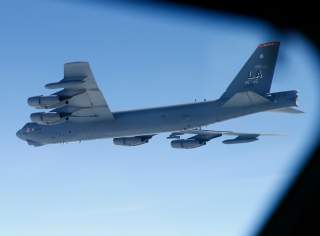Cold War Redux? Air Force B-52 Bombers Still Practice Nuclear Bombing Russia
Routine, but unnerving.
Key point: Just as they did during the Cold War, Moscow and Washington are sending their bombers to probe each other's defenses. Although commonplace, such missions are also risky.
The U.S. Air Force in early March 2019 deployed five B-52 bombers from Barksdale Air Force Base in Louisiana to the United Kingdom. Some of the eight-engine, long-range planes flew mock nuclear attacks on Russian soil.
The American operation mirrors Russia's own simulated aerial raids. In recent years Russian bombers have stepped up their probes of NATO and allied air space, occasionally following flight profiles matching atomic bombing runs.
Six B-52s arrived at the Royal Air Force base at Fairford starting March 14, 2019. "The deployment of strategic bombers to the U.K. helps exercise RAF Fairford as United States Air Forces in Europe’s forward operating location for bombers," the Air Force stated.
"The deployment also includes joint and allied training in the U.S. European Command theater to improve bomber interoperability. Training with joint partners, allied nations and other U.S. Air Force units contributes to our ready and postured forces and enables us to build enduring and strategic relationships necessary to confront a broad range of global challenges."
The Air Force's statement fails to mention one of the B-52s' other missions -- to practice nuclear attacks on Russia.
At least two of the B-52s that deployed to the United Kingdom are nuclear-capable models, identifiable by a special fin that the Air Force added in order to comply with the New START treaty that limits the number of U.S. and Russian nuclear-delivery systems.
But it was one of the non-nuclear-capable B-52s, serial number 60-0024, that initially flew a mock cruise-missile attack on Russia's Kaliningrad exclave on March 14, 2019, according to Steffan Watkins, an independent imagery analyst. Observers can track military flights via their transponders and radio traffic.
"USAF Boeing B-52H 60-0024 ... took off from Barksdale AFB [on] 2019-03-14 [at] 01:30 Zulu [time], flew over [Canada] and conducted a mock nuclear cruise missile strike on the Russian Federation, only turning around 60 nautical miles from Russian air space [at] 11:10 Zulu, landing at RAF Fairford [at] 13:32 Zulu," Watkins tweeted.
On March 28, five B-52s joined a pair of Royal Norwegian Air Force F-16AMs and a lone two-seat F-16BM for a mission over the Norwegian Sea.
"The deployment is clearly meant to be a signal of the U.S. military's strategic capabilities to America's 'great power' competitors, primarily Russia," Joseph Trevithick wrote at The War Zone.
"Though the Air Force has regularly sent small detachments of B-52s to the United Kingdom for training exercises throughout Europe over the years, having six of the bombers there at once is the single largest deployment of the [B-52s] to the region since the invasion of Iraq in 2003," Trevithick continued, citing Military.com. "During the opening phases of that conflict, 20 B-52s flew strike missions from the United Kingdom."
Compare the recent American bomber flights to Russia's own, similar flights. Eleven Russian Su-24 bombers in early 2018 flew a mock attack on a Norwegian radar site, Lt. Gen. Morten Haga Lunde, the director of Norway’s intelligence service, revealed in early February 2019.
Seventeen Russian warplanes in May 2018 buzzed the Royal Navy destroyer HMS Duncan in the Black Sea. And a year earlier in March 2017, nine Russian warplanes conducted another raid targeting a Norwegian military site. Three months later in May 2017, 12 Russian planes simulated attack runs on NATO vessels exercising in Norwegian waters.
NATO and allied warplanes routinely intercept Russian planes conducting mock raids. But Russian fighters did not interfere with the U.S. Air Force's March 14 mock raid. They, however, did intercept and monitor B-52 60-0024 and presumably other B-52s when they repeated the mock raid on March 20.
Russia swiftly retaliated. On March 29, 2019, two Russian air force Tu-160 nuclear-capable bombers flew over the North Sea, heading toward the United Kingdom. RAF fighters rose to intercept.
The dueling mock raids alarmed Hans Kristensen, a nuclear expert with the Federation of American Scientists. "If you missed signs of new Cold War, this should wake you up," Kristensen tweeted.
David Axe serves as Defense Editor of the National Interest. He is the author of the graphic novels War Fix, War Is Boring and Machete Squad. This first appeared in 2019.
Image: Reuters.

